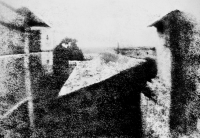








The history of photography has roots in remote antiquity with the discovery of the principle of the camera obscura and the observation that some substances are visibly altered by exposure to light. As far as is known, nobody thought of bringing these two phenomena together to capture camera images in permanent form until around 1800, when Thomas Wedgwood made the first reliably documented although unsuccessful attempt. In the mid-1820s, Nicéphore Niépce succeeded, but several days of exposure in the camera were required and the earliest results were very crude. Niépce's associate Louis Daguerre went on to develop the daguerreotype process, the first publicly announced photographic process, which required only minutes of exposure in the camera and produced clear, finely detailed results. It was commercially introduced in 1839, a date generally accepted as the birth year of practical photography.
The metal-based daguerreotype process soon had some competition from the paper-based calotype negative and salt print processes invented by Henry Fox Talbot. Subsequent innovations reduced the required camera exposure time from minutes to seconds and eventually to a small fraction of a second; introduced new photographic media which were more economical, sensitive or convenient, including roll films for casual use by amateurs; and made it possible to take pictures in natural color as well as in black-and-white.
The commercial introduction of computer-based electronic digital cameras in the 1990s soon revolutionized photography. During the first decade of the 21st century, traditional film-based photochemical methods were increasingly marginalized as the practical advantages of the new technology became widely appreciated and the image quality of moderately priced digital cameras was continually improved.
Photography is the result of combining several different technical discoveries. Long before the first photographs were made, Chinese philosopher Mo Ti and Greek mathematicians Aristotle and Euclid described a pinhole camera in the 5th and 4th centuries BCE.In the 6th century CE, Byzantine mathematician Anthemius of Tralles used a type of camera obscura in his experiments.
Ibn al-Haytham (Alhazen) (965 in Basra – c. 1040 in Cairo) studied the camera obscura and pinhole camera,Albertus Magnus (1193/1206–80) discovered silver nitrate, and Georges Fabricius (1516–71) discovered silver chloride. Daniel Barbaro described a diaphragm in 1568. Wilhelm Homberg described how light darkened some chemicals (photochemical effect) in 1694.The novel Giphantie (by the French Tiphaigne de la Roche, 1729–74) described what could be interpreted as photography.